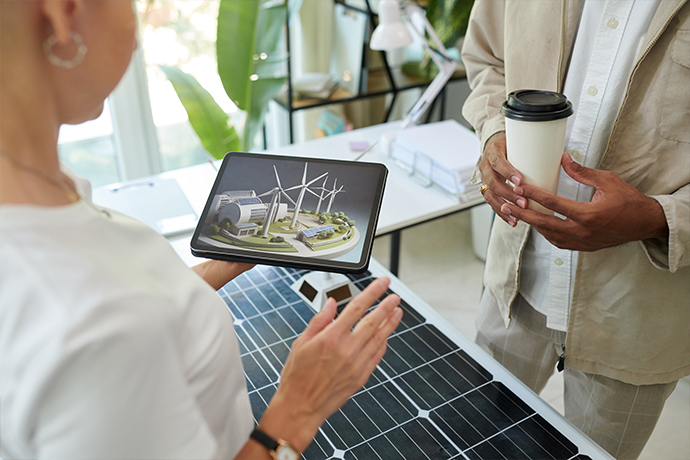 SPEAKERS
SPEAKERS
Delve into the pressing global conversation on climate crisis and environmental issues, highlighting the pivotal role of technology in shaping a sustainable future.

Today, the climate crisis and environmental concerns have become a global discussion issue. Looking at the gravity of the issue, it has become evident to look for a sustainable future and technology plays a major role in shaping such a future. People associated with technology and innovation understand this fact and thus strive to bring sustainable technology.
Sustainable technology refers to the solutions and practices, focused on reducing carbon footprint and minimizing adverse environmental impacts. In this article, you will get valuable insights into the huge world of sustainable technology and how its innovations drive positive change to attain a greener future.
Also known as “green” or “clean” technology, sustainable technology aims to deploy and develop solutions that can reduce pollution and waste, and minimize resource utilization while promoting social and economic sustainability. People associated with sustainable technology solutions consider problems like environmental degradation, resource depletion and climate crisis while ensuring social and economic expansion.
Sustainable technology is playing an important role in shaping the future of almost every industry. Let’s learn about different sustainable innovations coming from different industries.

Sustainable technology innovations mainly focus on renewable energy development, efficient resource utilization, environmental preservation and ensuring waste reduction. Based on these aspects and harnessing the power of science, creativity and engineering, every industry has developed a sustainable approach to mitigate environmental impact. Here are some examples.
One of the innovative solutions in sustainable technologies is energy-efficient technologies. These technologies focus on reducing energy waste and reducing resource consumption while maximizing energy efficiency.
One such example is the introduction of Smart grids. These grids help to monitor data in real-time so that you can optimize, control and manage energy utilization. With advanced sensors and automatic communication systems, these smart grids improve the efficiency of electrical infrastructure.
Further, the development of smart home appliances also contributes to reducing energy consumption. Be it energy-efficient lights or smart thermostats, all these innovative home solutions help to reduce carbon footprint and energy wastage.
Another important example of energy efficiency technology is smart energy storage solutions. Innovative lithium-ion batteries can help store and retrieve renewable energy while being affordable and efficient. Such intelligent energy storage technologies ensure grid stability, easy power backup during outages and allow improved integration of renewable energy.
Dependency on fossil fuels and increasing air pollution have been major environmental concerns for a while. Thanks to technological innovation in the transportation sector, now we have clean transportation options in the form of electric vehicles.
As technology is advancing, electric vehicles have become more affordable and accessible for common use. As compared to traditional gasoline-powered cars, EVs without any tailpipe emissions decrease carbon footprints and reduce the use of fossil fuels. Furthermore, the exploration of biofuels like biodiesel and ethanol offers cleaner options. Likewise, hydrogen fuels are also gaining popularity due to their zero emissions.
Other contributions to sustainable transportation solutions include Light rail transit, Bus rapid transit and other transit solutions. These solutions minimize traffic congestion and reduce individual vehicle usage.
All these innovations in the transportation sector aim to improve the quality of air, reduce carbon footprint, and promote eco-friendly mobility solutions.
The use of energy-efficient designs and recyclable building materials in the construction industry is another great example of sustainable technology. Green and smart buildings with efficient insulation, HVAC systems, high-performing windows and sensor-equipped roads optimize resource consumption and reduce carbon footprint. Other examples of sustainable technology include installing low-flow fixtures, incorporating water conservation systems, water-efficient landscaping or implementing rainwater harvesting systems
You know what’s the best part? With all such solutions, you can surely ensure sustainability but do not compromise on the functionality and aesthetics of the infrastructure. Be it passive design strategies or utilizing sustainable materials, designers and architects are integrating everything in their building plans.
Managing waste in a sustainable way means reducing its generation, promoting waste recycling and repurposing waste materials.
Technology has gifted us with innovative solutions to recycle wastes such as paper, plastic, metal or glass. Now, it is possible to extract valuable things from waste, reduce use of virgin materials and minimize environmental effects. Also, with newer technologies, waste is being converted into new products. Sustainable packaging helps to reduce the generation of waste.
Additionally, technology has evolved far enough to convert waste into energy. With techniques like anaerobic digestion and incineration, industries are working to generate energy like heat, biogas and electricity through organic waste. Such smart waste management not only reduces waste but gives another renewable energy alternative.
Sustainable innovations in agriculture technology aim to minimize environmental impact, foster biodiversity conservation and enhance resource utilization.
Precision farming is one such practice that uses satellite images and advanced sensors to manage crops. With precision farming, farmers can monitor crop and soil conditions, precise use of pesticides and fertilizers, enhance crop production and target resources when and where required.
Adopting organic farming over traditional farming practices has also helped farmers to mitigate use of harmful pesticides and focus on soil health and the environment. Organic farming also promotes composting, crop rotation and biological pest control to yield healthy produce.
Also, sustainable irrigation systems such as drip irrigation reduce water wastage to a large extent. Other agricultural practices that utilize land to its maximum capacity and reduce water consumption include vertical farming and hydroponics.
One of the key focus areas of tech sustainability aims to develop clean energy solutions to be used in different industries to curb carbon emissions, reduce dependency on fossil fuels and mitigate climate change.
One of the renewable energy solutions is the development of efficient and affordable solar energy. The development of reliable wind turbines has also contributed to the development of wind energy. efforts are also being made to utilize tidal energy and hydropower to generate electricity.
Efforts are also being made to develop a greener IT industry by use of energy-efficient products, server virtualization and data centers. Thanks to data analytics and IoT, you can monitor and optimize resource utilization. Further, researchers are also working to develop improved processors to reduce the carbon footprint that comes with existing computing devices.
Green IT practices mainly aim to reduce the use of hazardous materials, promote use of biodegradable products and maximize energy efficiency. Also, it works to minimize the effects of IT practices on nature by designing, operating, manufacturing and disposing of PCs and other computer products in a nature-friendly manner.

All the above-mentioned sustainable technologies strive to bring positive changes in the environment and enhance resource efficiency while maintaining social and economic well-being. We must understand to shape the future innovation trajectory, we need to adopt and implement sustainable technology in almost every aspect.
Though adoption and implementation look challenging, supporting government policies, financial incentives and widespread public awareness can help. For a more resilient, sustainable and prosperous future, we need to bring collective efforts and make conscious choices.
